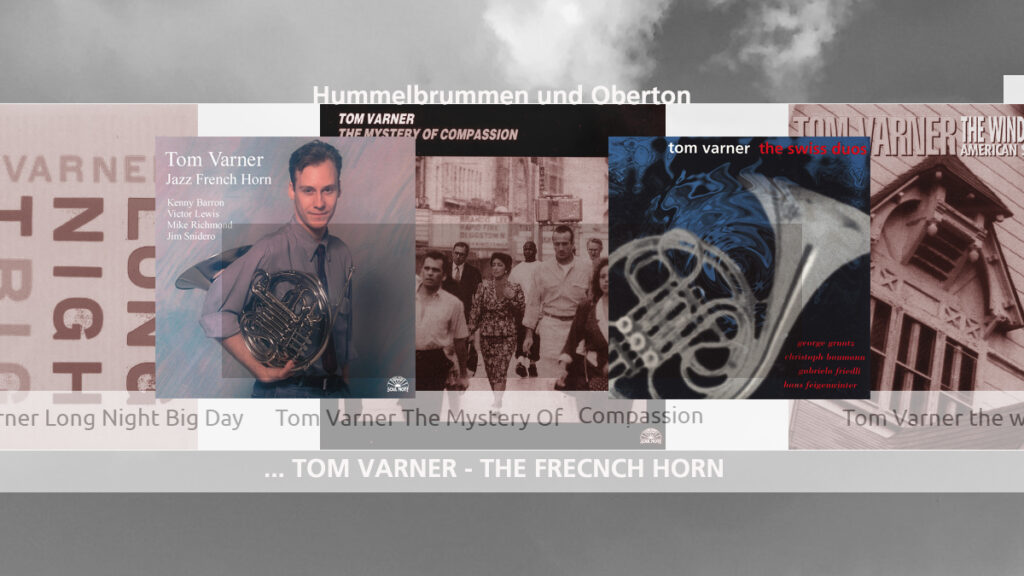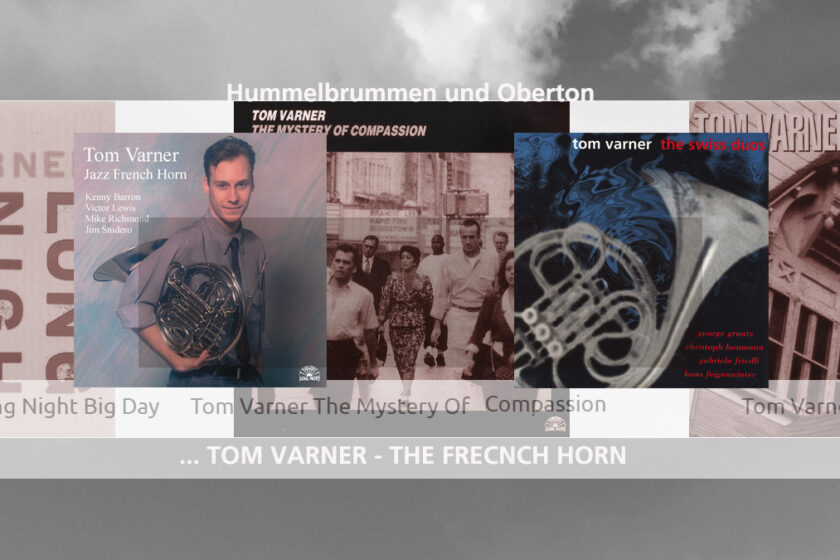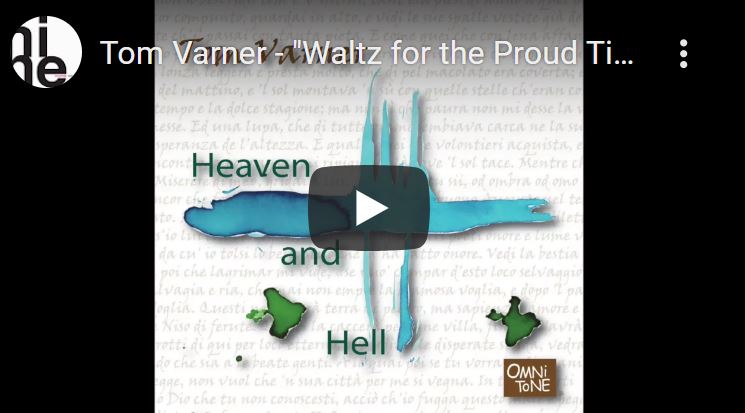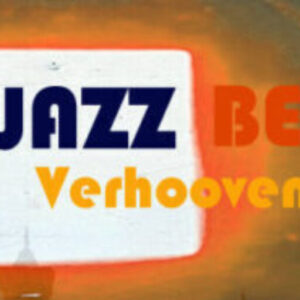Tom Varner Jazz French Horn
Tom Varner Jazz French Horn
Tom Varner (fh), Jim Snidero (sax), Kenny Barron (p), Mike Richmond (b), Victor Lewis (dr) Release 1985

Es gibt so einige Möglichkeiten, sich in der Musikszene einen Namen zu machen: du beginnst eine Bäckerlehre und backst Brötchen, du beginnst eine Elektrikerlehre und verdrahtest Wohnungen, oder du spielst Trompete und darfst dir einen Keller zum Proben suchen. Die weniger eindringlichen Werkzeuge aus der Sparte Blechblasinstrumente sind wohl Posaune und Waldhorn oder French Horn – es gibt viele Möglichkeiten, sich einen Namen in der Musikszene zu machen – ein Instrument spielen zum Beispiel, das nicht viele spielen.
Das Waldhorn oder French Horn ist so ein Instrument, außer zu Hochzeiten oder Jagden (Hier das Horn ohne Tasten) oder im Posaunenchor tritt es eher selten in Erscheinung. Vom Sound her einer Posaune nicht unähnlich, zu spielen wie eine Trompete und trotzdem bleibt der Ton immer weich, zurückhaltend oder gedämpft.
Zum Waldhorn und dem Wissenswerten darüber bitte bei reisser musik weiterlesen …
Tom Varner Jazz French Horn * Tom Varner Jazz French Horn * Tom Varner Jazz French Horn
Wir fragen uns weiterhin, warum nun ein Instrument, das wie eine Posaune klingt, sich wie eine Trompete spielen lässt und den Ton aber quasi an der kalten Schulter vorbei nach hinten ablässt, überhaupt im Jazz ankommt, nun, unschwer zu erkennen, man kann es wie auf dem Cover auch als Trophäe durch die Welt tragen. Außerdem: aber sicher doch: um im Jazz anzukommen mit so etwas, braucht es auch besondere Fähigkeiten am Instrument, nicht wahr? Einen eigenen Sound oder das gewisse Mehr an Optionen.
Wir präsentieren hier die dritte Aufnahme von Tom Varner, eine reife Leistung nach den beiden eher bemühten Alben Tom Varner Quartet und Motion/Still. Von Motion/Still heißt es bei Peter Rüedi, es handele sich um eine etwas spröde aber sehr lebendige Aufnahme – den Widerspruch in diesem Satz konnte ich nicht auflösen und widmete mich, nachdem Sprödigkeit und Lebendigkeit nicht zusammenkamen, dem Album aus dem Jahr 1985, Titel Jazz French Horn.
Einfach schlicht und leise, könnte man sagen, es setzt dich trotzdem fest. Es tut nirgends weh, läuft wie am Schnürchen … ein gradliniges Projekt, heißt es auf Wiki. – Die typische Mischung aus Standards und Eigenkomposition, landläufig Mainstream-Bop genannt oder Modern Jazz mit Attitüde, vordergründig also nichts Besonderes, wenn da eben nicht Tom Varner wäre am French Horn, das Tupferl auf dem Bonbon, oder eben der Virtuose am French Horn, eine Soundkollage mit Oberton.
Zur Biografie: von A – Z zu erkennen – nur das Who is Who der Jazzwelt : Steve Lacy, Dave Liebman, George Gruntz, John Zorn, Bobby Watson, La Monte Young, Miles Davis, mit Quincy Jones, Bobby Previte, Jim McNeely, McCoy Tyner, Reggie Workman, dem Mingus Orchestra und Franz Koglmann.
Er ist auf mehr als 70 Alben zu hören. Außerdem gibt es 13 Alben als Komponist und in Eigenregie, mit Steve Wilson, Tony Malaby, Ed Jackson, Ellery Eskelin, Tom Rainey, Cameron Brown, Drew Gress, Matt Wilson, Kenny Barron, Victor Lewis, Fred Hopkins und Billy Hart.
Nehmen wir noch die Preise und Auszeichnungen (Wikipedia) hinzu: „Seit Mitte der 1990er Jahre ist Varner jährlich in den Top Ten des Down Beat Critics Poll vertreten. Er erhielt Stipendien von der Jack Straw Foundation, dem Seattle’s 4Culture, dem National Endowment for the Arts, der Chamber Music America/Doris Duke Foundation und war Stipendiat der MacDowell, Blue Mountain Center und Centrum Arts Colonies.“
Weiter heißt es: „Die ersten beiden Aufnahmen, die Varner als Leader machte, waren von Ornette Coleman, Steve Lacy, Charles Mingus, Anthony Braxton und Minimalisten wie Steve Reich und Philip Glass beeinflusst. Hier nun : Seine dritte Aufnahme war ein eher geradliniges Jazzprojekt mit Kenny Barron, Jim Snidero, Mike Richmond und Victor Lewis.
Das vierte Projekt war ein von Sonny Rollins beeinflusstes Trio aus Horn, Bass (Mike Richmond) und Schlagzeug (Bobby Previte). Von diesem Zeitpunkt an (1987) arbeitete Varner hauptsächlich als Leader für ein Quintett mit Horn und zwei Saxophonen, Bass und Schlagzeug, wobei er die Ensembles häufig durch Gastmusiker ergänzte.
In fast allen seinen nachfolgenden Projekten hat Varner zeitgenössische Kammermusik mit Jazz und freier Improvisation kombiniert.“
Hervorheben möchte ich vor allen zwei weitere Aufnahmen von Tom Varner:
The Mystery Of Compassion (1992) – Mike Richmond (b), Tom Rainey (dr), Ed Jackson (sax), Rich Rothenberg (sax), Mark Feldman (vio) – das ergibt ein vielseitiges Instrumentarium und ein ebenso vielstimmiges Album zu Ehren Alban Bergs und Charlie Mingus als urbanen Mix mit Wurzeln in Soundtracks des Noir-Film (Brian Olewnick).
The Swiss Duo (1998) – Das ist Tom Varner mit Begleitung am Piano George Gruntz (p), Christoph Baumann (p), Gabriela Friedli (p) und Hans Feigenwinter (p) – mit jeweils unterschiedlicher Intonation und eigenem Temperament. Aufregend, spannungsgeladen und auch mit einigem an ironischen Ohrenspitzen bei den Bach-Choral-Adaptionen.
Varner lebte von 1979 bis 2005 in New York City und wohnt jetzt in Seattle. Er ist jetzt außerordentlicher Professor für Musik am Cornish College of the Arts.
Referenzen: Bandcamp | Wikipedia | Interview with Allaboutjazz 1999
Weitere bekannte Woldhornisten: Julius Watkins – John Clark – Vincent Chancey | ein Überblick: Frenchhorn in Jazz

Tom Varner Jazz French Horn
English Version
There are so many ways to make a name for yourself in the music scene: you start an apprenticeship as a baker and bake rolls, you start an apprenticeship as an electrician and wire apartments, or you play the trumpet and get to find a basement to rehearse in. The less intrusive tools from the brass division are probably trombone and French horn or French horn – there are many ways to make a name for yourself in the music scene – playing an instrument, for example, that not many play.
The French horn is such an instrument, except for weddings or hunts (here the horn without keys) or in the trombone choir it appears rather rarely. From the sound of a trombone not dissimilar, to play like a trumpet and yet the tone always remains soft, restrained or muted.
To the French horn and the worth knowing about it please read on at reisser musik …
We continue to ask ourselves why an instrument that sounds like a trombone, can be played like a trumpet and lets the sound off to the rear past the cold shoulder, so to speak, arrives in jazz at all, well, it’s not hard to see, you can also carry it around the world as a trophy, as on the cover. Besides: but surely: to arrive in jazz with something like this, you also need special skills on the instrument, don’t you? A sound of one’s own or that certain extra of options.
We present here the third recording by Tom Varner, a mature achievement after the two rather laboured albums Tom Varner Quartet and Motion/Still. About Motion/Still Peter Rüedi says that it is a somewhat brittle but very lively recording – I could not resolve the contradiction in this sentence and, after brittleness and liveliness did not go together, devoted myself to the album from 1985, title Jazz French Horn.
Just plain and quiet, you could say, it still sets you down. It doesn’t hurt anywhere, runs like clockwork … a straightforward project, Wiki says. – The typical mixture of standards and original compositions, commonly called mainstream bop or modern jazz with attitude, superficially nothing special, if it weren’t for Tom Varner on the French horn, the dab on the candy, or the virtuoso on the French horn, a sound collage with overtones.
About the biography: from A – Z to recognize – only the Who is Who of the jazz world : Steve Lacy, Dave Liebman, George Gruntz, John Zorn, Bobby Watson, La Monte Young, Miles Davis, with Quincy Jones, Bobby Previte, Jim McNeely, McCoy Tyner, Reggie Workman, the Mingus Orchestra and Franz Koglmann.
He can be heard on more than 70 albums. There are also 13 albums as a composer and on his own, with Steve Wilson, Tony Malaby, Ed Jackson, Ellery Eskelin, Tom Rainey, Cameron Brown, Drew Gress, Matt Wilson, Kenny Barron, Victor Lewis, Fred Hopkins and Billy Hart.
Let’s add the awards and accolades from Wikipedia: Varner has been in the top ten of the Down Beat Critics Poll every year since the mid-1990s. He has received grants from the Jack Straw Foundation, Seattle’s 4Culture, the National Endowment for the Arts, the Chamber Music America/Doris Duke Foundation, and has been a MacDowell, Blue Mountain Center, and Centrum Arts Colonies grantee.
It goes on to say, „The first two recordings Varner made as a leader were influenced by Ornette Coleman, Steve Lacy, Charles Mingus, Anthony Braxton, and minimalists such as Steve Reich and Philip Glass. Here now : His third recording was a more straight jazz project with Kenny Barron, Jim Snidero, Mike Richmond and Victor Lewis.
The fourth project was a Sonny Rollins influenced trio of horn, bass (Mike Richmond) and drums (Bobby Previte). From that point on (1987), Varner worked primarily as a leader for a quintet with horn and two saxophones, bass, and drums, often adding guest musicians to the ensembles.
In almost all of his subsequent projects, Varner has combined contemporary chamber music with jazz and free improvisation.„
I would like to highlight two other recordings by Tom Varner: and
The Mystery Of Compassion (1992) – Mike Richmond (b), Tom Rainey (dr), Ed Jackson (sax), Rich Rothenberg (sax), Mark Feldman (vio) – this makes for a versatile instrumental and equally polyphonic album honoring Alban Berg and Charlie Mingus as an urban mix with roots in noir film soundtracks (Brian Olewnick).
The Swiss Duo (1998) – This is Tom Varner with accompaniment on piano George Gruntz, Christoph Baumann, Gabriela Friedli and Hans Feigenwinter – each with different intonation and temperament. Exciting, full of suspense and also with some ironic ear-tip in the Bach chorale adaptations.
Varner lived in New York City from 1979 to 2005 and now resides in Seattle. He is now associate professor of music at Cornish College of the Arts.

Vip Gold – the very important of Jazz





